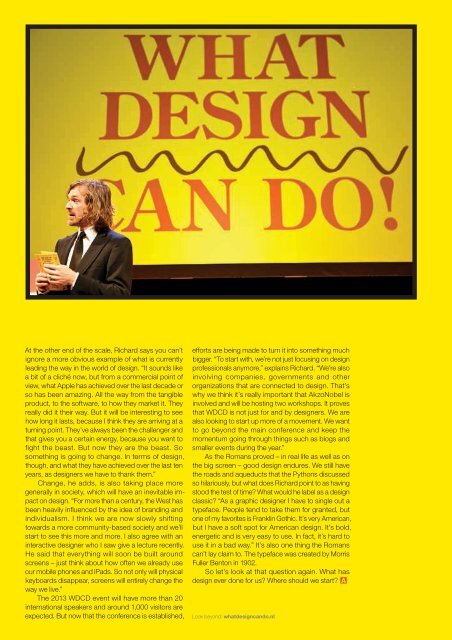tOMOrrOW's AnsWers tODAY - AkzoNobel
tOMOrrOW's AnsWers tODAY - AkzoNobel
tOMOrrOW's AnsWers tODAY - AkzoNobel
You also want an ePaper? Increase the reach of your titles
YUMPU automatically turns print PDFs into web optimized ePapers that Google loves.
16<br />
Everyone of my generation of 50-somethings<br />
will probably remember having a globe at<br />
school. I recall ours stood in the corner of our<br />
geography master’s office – a dented, tinny,<br />
rather cheap looking football-sized sphere with<br />
textured mountains and shiny discolored seas.<br />
A relic perhaps of a time when the sun never set<br />
on the Empire, it looked as if it had seen better days.<br />
Every single one of a constant procession of wayward<br />
schoolboys over the years must have given it a hard,<br />
but surreptitious, spin or traced some imaginary<br />
journey with their grubby fingertips when called to<br />
account in that dark and, for us, forbidding place.<br />
Perched on the corner of the redoubtable Mr.<br />
Smith’s well-worn desk, it must at one time have<br />
symbolized colonial power, but now was a timely, yet<br />
forlorn reminder of the world that lay at our feet and<br />
of a wider universal truth that Copernicus and Galileo<br />
had suffered the wrath of the medieval church to bring<br />
to us – that we live on a world that is not flat, but an<br />
imperfect sphere slowly spinning in space and time.<br />
A truth only officially acknowledged in 1992 when the<br />
Vatican conceded that the Earth was not stationary,<br />
thus pardoning Galileo 500 years after he had upset<br />
the status quo.<br />
The globe’s origins date back to antiquity and the<br />
intellectual curiosity of the ancient Greeks. Hellenistic<br />
philosophers had long speculated about the Earth’s<br />
shape, but finally established that it was spherical and<br />
not flat in the 3rd century BC. Before long, “celestial”<br />
globes depicting the heavens appeared in artwork –<br />
Atlas carrying the heavens on his shoulders for<br />
eternity is an image we all know. In 150 BC, the first<br />
“terrestrial” globe was made by Crates of Mallus. The<br />
oldest surviving globe is the Erdapfel, which was<br />
made by Martin Behaim in Nuremberg, Germany, in<br />
1492, the year Columbus discovered – or rather<br />
stumbled upon –the Americas, earnestly believing<br />
that he had found the gateway to the Orient. Needless<br />
to say, map making was painfully in its infancy.<br />
The 18th, 19th and early 20th centuries were the<br />
golden age for globes – a time when the European<br />
powers were hell bent on carving out huge empires<br />
and the scramble for Africa was at its height. Men<br />
such as Henry Morton Stanley, Pierre Savorgnan de<br />
Brazza, Charles Gordon of Khartoum, Jean-Baptiste<br />
Marchand and Hubert Lyautey tickled the public’s<br />
imagination as they braved unimaginable dangers<br />
among “savage” people for the nation’s greater good.<br />
At home, an information hungry public was fed neverending<br />
stories of derring-do, swashbuckling<br />
adventure and extraordinary feats of valor in the face<br />
of terrifying odds, all of which was accompanied by<br />
detailed maps of their hero’s endeavors. What better<br />
way to trace their progress than with a globe?<br />
Today, while maps abound in the media, online<br />
and for the navigation-savvy owners of smartphones<br />
and in the logos of globally active companies, globes<br />
seem to be about as popular as ceramic ducks on a<br />
living room wall. It would be disingenuous of me to<br />
say I can remember a time when they were a common<br />
sight in offices or houses. Even schools, for a long<br />
time their standard bearer (particularly for explaining<br />
history and geography), no longer have them in the<br />
classroom. Once the centerpiece of our learning<br />
experience, for many they now seem an anachronism<br />
in the modern digital age. So are they on the slippery<br />
slope to oblivion?<br />
Not at all, says Peter Bellerby of Bellerby & Co.<br />
Globemakers. A globe maker since 2008, the<br />
Established in 2008, Peter Bellerby’s<br />
globemaking studio is located in London.<br />
Photography: Jake Curtis.
















